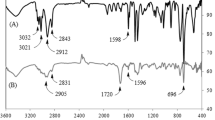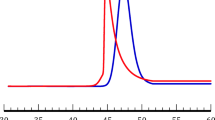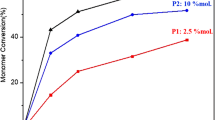Abstract
This article describes the synthesis of 4,4′-methylenediphenyl diisocyanate (MDI) based polyurethane-ureas-amide using diamine-diamide chain extenders and dihydroxy polystyrene (PSt) having a weight average molecular weight of 2000 g/mol. The weight average molecular weight of the soft segment is varied from 2000 to 10,000 g/mol using MDI as a chain extender and thereby changing the hard segment content from 30 to 17 wt% in the copolymer. The inherent viscosity of the polymer is found to be in the range of 1.6–3.4 dL/g is suggesting that the polymer is of high molecular weight. FT-IR results conclude that the urea groups form monodentate assemblies. DSC data show the peaks for Tg of soft and Tm of hard segments. Depending on the amide concentration, the melting temperature of the polymer varies from 189 to 249 °C. Also, at high concentration of the hard segment, the cooling curve shows crystallization exotherm peak. The entire series of polymer shows single stage decomposition temperature centered around 400 °C shown by the TGA measurement. The solubility of the polymer in chloroform and swelling ratio is depending on the concentration of the hard segment. The studied polymer shows excellent solvent resistivity.









Similar content being viewed by others
References
Król P (2007) Synthesis methods, chemical structures and phase structures of linear polyurethanes. Properties and applications of linear polyurethanes in polyurethane elastomers, copolymers and ionomers. Prog Mater Sci 52:915–1015
Wang CB, Cooper SL (1983) Morphology and properties of segmented polyether polyurethaneureas. Macromolecules 16:775–786
Rogers ME, Long TE (2003) Synthetic methods in step-growth polymers, vol 4. Wiley-Interscience, Hoboken
Zhang Q, He H, Xi K, Huang X, Yu X, Jia X (2011) Synthesis of N-Phenylaminomethyl POSS and Its Utilization in Polyurethane. Macromolecules 44:550–557
Bates FS, Hillmyer MA, Lodge TP, Bates CM, Delaney KT, Fredrickson GH (2012) Multiblock polymers: panacea or Pandora’s box? Science 336:434–440
Russell TP, Karis TE, Gallot Y, Mayes AM (1994) A lower critical ordering transition in a diblock copolymer melt. Nature 368:729–731
Zhang L, Eisenberg A (1995) Chemically induced supramolecular reorganization of triblock copolymer assemblies: trapping of intermediate states via a shell-crosslinking methodology. Science 268:1728–1731
Li Y, Ren Z, Zhao M, Yang H, Chu B (1993) Multiphase structure of segmented polyurethanes: effects of hard-segment flexibility. Macromolecules 26:612–622
Li Y, Kang W, Stoffer JO, Chu B (1994) Effect of hard-segment flexibility on phase separation of segmented polyurethanes. Macromolecules 27:612–614
Lee DK, Tsai HB (2000) Properties of segmented polyurethanes derived from different diisocyanate. J Appl Polym Sci 75:167–174
Gao R, Zhang M, Wang SW, Moore RB, Colby RH, Long TE (2013) Polyurethanes containing an imidazolium diol-based ionic-liquid chain extender for incorporation of ionic-liquid electrolytes. Macromol Chem Phys 214:1027–1036
Biemond GJE, Brasspenning K, Gaymans RJ (2012) Synthesis and selected properties of polyurethanes with monodisperse hard segments based on hexane diisocyanate and three types of chain extender. J Appl Polym Sci 124:1302–1315
Chang Z, Zhang M, Amanda G, Hudson E, Orler B, Robert B, Moore GL, Wilkes S, Turner R (2013) Synthesis and properties of segmented polyurethanes with triptycene units in the hard segment. Polymer 54:6910–6917
He Y, Zhang X, Runt J (2014) The role of diisocyanate structure on microphase separation of solution polymerized polyureas. Polymer 55:906–913
Kayalvizhi M, Vakees E, Suresh J, Nagarajan S, Arun A (2014) Spacer length controlled hghly thermo reversible polyurethane-urea based on polystyrene: synthesis and crystallization studies. Polym Adv Technol 26:160–166
Kayalvizhi M, Vakees E, Suresh J, Arun A (2015) Poly(urethane-urea) based on functionalized polystyrene with HMDI: synthesis and charecterisation. Arab J Chem. doi:10.1016/j.arbjc.2015.04.005
Van der Schuur M, Feijen J, Gaymans RJ (2005) Synthesis and characterization of bisester-amide segments of uniform and random length. Polymer 46:4584–4595
Van der Schuur M, Noordover B, Gaymans RJ (2006) Polyurethane elastomers with amide chain extenders of uniform length. Polymer 47:1091–1100
Vakees E, Suresh J, Kayalvizhi M, Srinivasan VV, Arun A (2013) Synthesis and characterization of functionalized polystyrene using ATRP with strong base technique. IOSR-J Appl Chem 7(4):32–38
Krijgsman J, Husken D, Gaymans RJ (2003) Synthesis and characterisation of uniform bisester tetra-amide segments. Polymer 44:7043–7053
Yilgör E, Burgaz E, Yurtsever E, Yilgör L (2000) Comparison of hydrogen bonding in polydimethylsiloxane and polyether based urethane and urea copolymers. Polymer 41:849–857
Oertel G (1985) Polyurethane Handbook. Carl Hanser, Munich, p 31
Kayalvizhi M, Vakees E, Suresh J, Arun A (2015) Manuscript send to Journal
Desai S, Thakore IM, Sarawade BD, Devi S (2000) Effect of polyols and diisocyanates on thermo-mechanical and morphological properties of polyurethanes. Eur Polym J 36:711–725
Ya-Jen Yu (2011) The effect of moisture absorption on the physical properties of polyurethane shape memory polymer foams. National Taiwan University, Taiwan
Acknowledgments
We wish to thank the Department of Science and Technology (DST), India for their financial support under Fast Track Scheme for Young Scientists to Dr.A.Arun (No.SR/FT/CS-018/2009).
Author information
Authors and Affiliations
Corresponding author
Rights and permissions
About this article
Cite this article
Kayalvizhi, M., Suresh, J., Karthik, S. et al. Synthesis and characterization of MDI and functionalized polystyrene based poly(urethane-urea-amide). Int J Plast Technol 20, 128–142 (2016). https://doi.org/10.1007/s12588-016-9145-4
Received:
Accepted:
Published:
Issue Date:
DOI: https://doi.org/10.1007/s12588-016-9145-4




